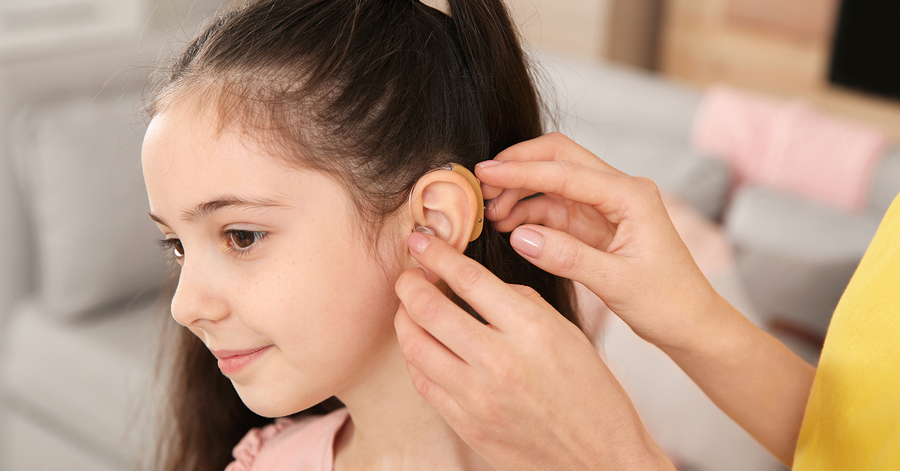While many of the infant and childhood hearing loss statistics are harrowing, there are several steps you can take to protect your child’s hearing and ensure they have a brighter future. The experts at North Shore Hearing P.C. offer a range of different hearing solutions designed for children, including a free hearing screening. Contact North Shore Hearing P.C. today to schedule your child’s free hearing screening.
When Does a Baby Begin Hearing?
Your child’s hearing is one of the first senses they develop. Around week nine of the pregnancy, indentations will appear where your baby’s ears will be. Nine weeks later in week 18, your precious baby will begin to hear sounds. By week 24, the baby will be much more sensitive to sounds; and between weeks 25 and 26, most babies will respond to voices and noises in the womb. The limited sounds your baby will hear at this point are those you may not even notice, such as:
- The gentle rhythmic beat of your heart,
- The growling of a hungry stomach,
- The flow of air moving in and out of your lungs, and even
- The sound of blood flowing through the umbilical cord.
Hearing Loss at Birth
Approximately one to three of every 1,000 babies are born with hearing loss. At the same time, an estimated 33 babies (one out of 1,000 newborns) are born profoundly deaf or have substantial permanent hearing loss. The underlying cause of hearing loss may include:
- Certain medications
- Premature delivery
- Meningitis
- Frequent ear infections
- Amount of time spent in neonatal intensive car unit
- Exposure to very loud sounds
- High levels of bilirubin that requires a transfusion
- Family history
The majority of babies born with hearing loss are diagnosed through a test, while other children may be diagnosed later in childhood. In either case, it’s imperative to have a hearing screening for your child before they are a month old.
Why? Because babies learn to talk by imitating the sounds they hear from you and others around them. If they are unable to properly hear those sounds, it can result in developmental delays. If your child has been diagnosed with hearing loss, most experts suggest you should consider the use of hearing devices as well as other options before they are six months.
How to Treat Hearing Loss in Infants?
If your infant has been diagnosed with hearing loss, they can be fit with an amplification device as young as four weeks. And whenever appropriate early intervention steps are taken, the majority of children who have significant hearing loss or are deaf will be mainstreamed successfully into regular elementary and secondary education classrooms.
In addition, most research suggests early identification paired with appropriate hearing technology — cochlear implants and hearing aids — enable several children who are hard of hearing or deaf to develop language skills comparable to their peers who do not suffer hearing loss.
The Three Types of Hearing Loss in Babies and Children
Most parents are surprised to learn all hearing loss isn’t the same. In fact, hearing loss can be categorized in three separate categories, which greatly influences the treatment options.
Conductive Hearing Loss
Conductive type of hearing loss is the result of sound being muffled or blocked in the ear canal or middle ear. With this type of hearing loss, sound is prevented from entering the middle ear, which can cause sounds and voices to be distorted, faint or both. Conductive hearing loss can be caused by ear infections, punctured ear drums, hereditary, trauma, or blockages of wax. In most instances, conductive hearing loss can be treated surgically or medically.
Sensorineural Hearing Loss
As the most common type of hearing loss, sensorineural type of hearing loss is often referred to as nerve-related deafness. This condition involves damage to the inner ear structures that maybe related to birth defect, prenatal defects, aging (commonly called age-related deafness), bacterial infections, viral infections, exposure to loud noise, trauma, hereditary, inner ear tumors, or fluid backup. Virtually all types of sensorineural hearing loss can be treated with hearing aids.
Mixed Hearing Loss
Mixed type of hearing loss refers to a combination of both sensorineural as well as conductive hearing loss, which means a problem occurs in both the inner and middle or outer ear.
Childhood Hearing Loss Statistics Not Parent Should Ignore
Hearing loss can impact your child at any age and can be caused by a variety of factors. And if the hearing loss isn’t treated, it can become progressively worse and impact various other parts of their life. The Centers for Disease Control reports 14.9% of children between the ages of 6 and 19 suffer from high or low frequency hearing loss in one ear (single-sided deafness) or both ears.
And even the mildest form of hearing loss can substantially interfere with a child’s education performance and reception of spoken language. For example, children who have mild hearing loss can miss as much as 50% of what’s said in the classroom.
At the same time, these children may be improperly labeled as having a behavior problem — when they simply are unable to hear well. Children who have hearing loss in one ear are 10 times more likely to be held back a minimum of one grade compared to a child with no hearing loss.
Contact North Shore Hearing P.C. Today to Schedule a Hearing Exam for Your Child
As a parent, there isn’t anything you wouldn’t do to protect your child! And ensuring your child can effectively hear to learn and experience the world is a simple step you can take to secure their future. Fortunately, the hearing experts and specialists at North Shore Hearing P.C. can help. Contact us today for a free consultation or to schedule a hearing screening for your child.


